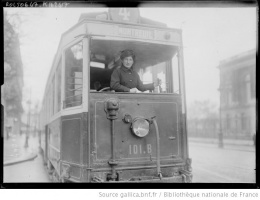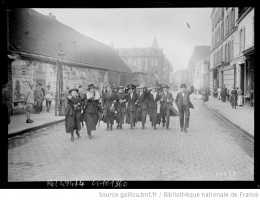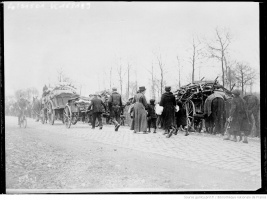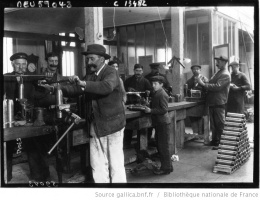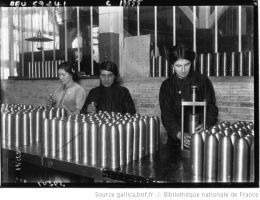Introduction↑
The outbreak of the First World War resulted in significant difficulties for the French economy. During the first two weeks of August 1914, nearly 3 million Frenchmen were mobilized and left their jobs. They were typically the youngest and most vigorous men. Many firms had to be closed either because the owner had been mobilized or because of insufficient manpower. In addition, German occupation deprived France of the wealthiest and most industrial part of its territory and triggered the flight of several thousand refugees from northern France.
At the beginning of war, 2 million workers were unemployed. The crisis was particularly tough in Paris. First of all, the city lost access to northern France, its source of raw materials. Given its location close to the front, military authorities mobilized all resources to defend the city. A significant portion of its population left in September 1914. In August 1914, according to the factory inspectors, the employment rate fell to 70 percent of pre-war levels; in addition, 68 percent of the capital’s workshops closed.[1]
The government responded by creating employment agencies; these provide information about the evolution of unemployment throughout the war.[2] After remaining at high levels in the second half of 1914, unemployment started declining from 1915 on, thanks to the resumption of economic activity and the efforts of the employment agencies. In January 1916, the companies had reached 76 percent of their pre-war staff; by January 1917 the level had increased to 92 percent.[3]
The war became a period of intense activity. The industrial character of the conflict increased the importance of armament production. Under these circumstances, the number of workers in war factories remained insufficient. Labour can thus be viewed through the prism of the workforce crisis, which affected the wage level, worsened working conditions, altered relationships with the front and fed the labour movement’s claims.
Evolution of Workers’ Income↑
The evolution of the wage level is difficult to estimate because of defective and unreliable statistic sources.[4] Data is heterogeneous and not unified at a national scale. It stems from several sources, including the Statistique générale de la France, the ministries of labour and agriculture, industrial groups, local political actors, and the conseils des prud’hommes (industrial tribunals), to such an extent that it is hard to make precise comparisons between different industrial branches.
During the first months of the war, wages dropped significantly by as much as two-thirds (for example for milliners). The situation improved from 1915 on owing to the workforce’s rising needs. The wages evolution followed inflation, but with some delay.[5] Thus, the price increase in Paris was moderate until 1916, before reaching high levels in 1917.[6] Consequently, the real rise of wages only took place in spring 1917.
During the war, wage gaps tended to decrease. Actually, wage increases granted to the workers reduced differences between regions and skill levels.[7] Thus, the wages of unskilled workers rose faster than those of skilled workers, which were much higher before the war. This evolution was the result of the unification of consumer goods prices at a national scale, but mostly of the aid policies implemented by public authorities. To produce all the ammunition required by the war, the state had to make important social expenses. This tendency to wage unification contributed to the skilled workers’ feeling a drop in status. On the other hand, differences increased between trade and industry in favour of the war factories’ workers. The difference was particularly evident for women. In the war factories, the “munitionnettes” executed less skilled tasks but were better paid than in the traditional female areas of dressmaking and the clothing trade.
Finally, the war considerably altered the weight of the wage in workers’ incomes. Actually, the nominal wage was supplemented by high living allowances (allocations de cherté de vie) from 1917 on. These allowances were all the higher when wages were low. The recipients’ family expenses were also taken into account when calculating the amount. The number of wages in a family changed too. Whereas the army took care of the mobilized men’s work needs, the labour shortage led the other family members – women and children – to work. Therefore, even though the individual wage hardly rose, some families saw their total incomes increasing.[8]
Worsening Working Conditions↑
Paradoxically, wartime saw both worsened working conditions and the development of a protective and contractual labour legislation under the control of the ministries of labour and armament.
Wartime was a period of intense activity. The unemployment rate was extremely low as many workers took advantage of steadier employment conditions. However, to meet production needs, working hours increased considerably with negative consequences on workers’ health. Thus, the real working day of the railwaymen of the Compagnies du Nord and de l’Est increased from an average of 9.5 hours per day before the war to twelve hours.[9] Some train drivers from the Compagnie du Nord even worked seventy-two hour shifts. Night work was permitted and dangerous jobs were left to women and children. Sunday rest was removed. The number of work accidents increased significantly due to workers’ exhaustion and lack of experience.
General living conditions also declined. The number of homes decreased due to war destruction and the increasing concentration of workers in production centres. As a result, many workers were housed in makeshift barracks. They also had to endure hardships and shortages. Food products were lacking; the quality of bread decreased. The lack of coal was particularly sensitive since the coalmines of northern France were occupied. The terrible and exceptionally cold winter of 1916-1917 demanded the people’s sacrifice.
Worsening working conditions led Albert Thomas (1878-1932), the minister of armament, to create a worker service (Service ouvrier) charged with protecting the men who worked for the national defence. The measures taken during the war aimed to increase wages and put mobilized workers’ salaries on the same level as other workers. On 16 January 1917 a law unified wages and set a minimum wage for all men working for the national defence. The rates were quite high and led to wage increase in the other industry branches. This policy aimed to raise productivity by granting high wages to workers.
Albert Thomas also implemented other progressive benefits for the munitions workers: medical inspections, breastfeeding rooms, restrooms, and institutional catering, to name a few. He created consultation authorities to mediate between employers and workers in the war factories in order to avoid social conflicts. At the end of 1916, he created workshop delegates (délégués d’atelier) in charge of negotiating contentious issues with employers. In January 1917, each industrial region was given a permanent committee of conciliation and arbitration for workers and employers; it was in charge of all wage issues and conflicts within the war industry. These creations show Albert Thomas’ wish to improve the relationship between workers and employers by creating dialogue spaces that had not previously existed. They contributed to a social reformism supported by the Confédération générale du Travail (CGT, General Confederation of Labour) from December 1916 and were built on three pillars: growing production, a stronger state and the working class heading the post-war reconstruction. They also were criticized by the industrial leaders for encouraging the strikes.
In return, national defence employees worked more and the strikes were thus avoided.[10] Thus Albert Thomas’ policy must be analysed in light of the workforce shortage. His main objective as minister of armament was to avoid the strikes that would decrease production in the war industries. But in the long run, his policy also aimed to craft new relationships between workers and employers, embodied in the conciliation that would improve the workers’ situation.
The workforce crisis led the government to recall mobilized workers from the front. Little by little the gap between soldiers and the men who worked on the home front was widening.
Workers Face the “Blood Tax”↑
The First World War increased the opposition between the men who fought on the front and those who worked on the home front. The latter were often referred to as shirkers (embusqués), a word whose usage was developed as early as summer 1914.[11] Actually, owing to increasing industrial needs involved in conducting the war, the workforce crisis became the first constraint of the war economy from 1915 on. The republican conception of the equality of men in military service (the “blood tax”), reinforced by the egalitarian military law of 1905 and revived by the union sacrée, met with the necessity of recruiting skilled workers for the war factories.[12] The number of non-fighting men increased as the government withdrew men from the front and sent them to industries considered critical to the national defence. These practices nourished controversies and jealousies, widely relayed by the press, about the shirkers who escaped from the front. Peasants, tradesmen and employees who did not have skills useful for the war effort were particularly hostile to the workers returning from the front. The same division was seen at the political level (the labour movement leaders were supposed to be more likely to be called back from the front) or at a generational level (the young were favoured to the detriment of the old, who would have to stay on the front).[13] The figure of the shirker, with which the war factory workers were identified, crystallized the hostility between soldiers and the population. Their criticism also showed the mobilized soldiers’ jealousy in light of these workers’ quite high wages. The injustice was particularly sensitive among soldiers on the front when the family budget was supplemented by their wives.
In August 1915, the Dalbiez law was passed in order to send all men to fight on the front. It was not as efficient as expected, all the more after several exceptions were set in place. Actually, the law took into account the emergency of organizing the armament effort. It showed that the main objective was efficiency, not equality. So, the principle of the blood tax was replaced by the idea of “the right man in the right place”. Workforce needs were so large that they obliged Albert Thomas to prioritize the mobilized workers in the war factories over the other workers, which led to increased inequality from the blood tax perspective.
In 1916, the Battle of Verdun highlighted the French army’s ammunition needs even more clearly than before, and with it, the necessity to recruit more workers for the war factories. As the minister of armament kept asking for more workers, members of parliament and the press began to understand the industrial character of the war. They stopped denouncing shirkers and asked the military authorities for men. The weight of mourning also made them aware of the extent of the human losses supported by the country and contributed to this reversal.
In 1917, once mobilized, young Frenchmen were directly sent to the war factories, whereas the oldest soldiers spent their third winters on the front. The Mourier law, which held that all men between nineteen and twenty-four be sent to the fight, was passed to complement the Dalbiez law. However, to avoid a disorganization of the services, many exceptions for technicians were implemented, which showed that members of parliament and the press were aware of the increased industrial needs during the war. The effects of the Mourier law were limited: it only allowed 30,000 soldiers to be sent to the front, which show that the industrial requirements of the war prevailed over mass conscription. Employing workers in the war factories rather than on the front was better accepted in 1917. The debate about shirkers lost its intensity above all because the industrial character of the war was better understood.[14]
A New Working Class↑
The composition of the national workforce was greatly altered during the war. Branches linked to the war grew, in particular metallurgy and chemistry. Construction, the printing industry and fine craft, which did not contribute to the national defence, saw their staffs reduced by half. The war also modified the working-class geography and reinforced the weight of the industrial départements. Of the 1,800,000 workers active during the war, 300,000 worked in Paris, 100,000 in the Loire, and 80,000 in the Rhône. The maritime départements took advantage of the increase in imports and harbour activities. Finally, the départements with an old industrial centre or a state arsenal (the Cher with Bourges, the Charente with Angoulême, the Hautes-Pyrénées with Tarbes) experienced growing industrial activity as well.[15]
Economic needs linked to national defence led to an increase in hiring among women and youth. These groups found new sources of income that were greatly needed due to the increased cost of living. To meet labour demands, foreign and colonial workers were also employed. They totalled approximately 500,000 and came mainly from Spain and Northern Africa, but also from China.[16] Beginning in 1915, the government also sent prisoners of war to agriculture and industries asking for additional workers. When the armistice was signed, the war factories employed 30 percent military workers, 25 percent women, 12 percent foreigners, colonial and prisoners and 33 percent French civilians.[17] Nevertheless, the war did not contribute to a long-term improvement in these population groups’ labour situation. Actually, as soon as the armistice was signed, they were replaced by the mobilized soldiers and received no further professional training.
During the war, the mobility and heterogeneity of the working class increased. First, the workers coming from the occupied regions fled towards other regions. The needs of the munitions and aircraft sectors led to the industry’s geographic concentration and reinforced Paris’ influence. Many foreign workers were hired for one year before returning to their homeland. The working conditions differed between the various categories of workers: foreigners and colonials were subjected to a strict discipline. The prisoners of war had no rights. Military workers depended on the workforce control, organized by the minister of armament, and could be sent back to the front at any time.
This influx of many unskilled workers and the army’s urgent need for munitions led to a change in production methods. The main innovation was the rationalization of production in some French factories inspired by Taylor’s ideas, like Javel built by André Citroën (1878-1935), where each worker had a specific task to do.[18] This evolution led to the hiring of semi-skilled men. However, workers fought against the dilution and loss of their skills. This idea became one theme of the working protest during the war.
As a result, the working class appeared fragmented. Women and foreigners elicited the weariness and hostility of workers who felt replaced by them and who accused them of causing their departure to the front.[19] The workers were also split between native workers and those who came from other regions, who were often more involved in protest actions. In some regions, the workers originating from northern France and the Paris Basin spread revolutionary and union ideas and led the protest movements.[20]
An Increasing Movement of Protest↑
In the first months of the war, the workers’ mobilization emptied the union organizations’ rows.[21] The number of CGT contributors dropped from 350,000 before the war to 50,000 in 1915. Some union structures disappeared. The decrease in the socialist party’s members, although severe, was less strong: from 1914 to 1915, they went down from 90,000 to 25,000. The socialist sections managed to maintain activity and organized popular assistance at a local scale. Because of the disorganization of the union structures and the workers’ support for the union sacrée at the beginning of war, social conflicts were rare in the first two years of the war.
On the other hand, the last two years of the war constituted a period of strikes in an unprecedented extent. In Paris, strikers were estimated at 250,000 in 1917 and 210,000 in 1918.[22] A first crisis occurred in the winter 1916-1917, whose hardship was reinforced by the difficulties in supplying coal. Movements of discontent happened in the coal suppliers’ queues and xenophobic actions occurred against the colonial workers. The crisis extended to the spring 1917, when a price increase drastically diminished purchasing power. It put some categories of workers, women in particular, in an unbearable situation. The savers, the old people, the owners and the annuitants were also especially affected. At the same time, the offensive launched by General Robert Nivelle (1856-1924) in April 1917 was a failure, increasing the working class’ despair.
The main protests concerned wages, in reaction to the rapid price increase. Strikes broke out first in the war factories, owing to the considerable profits made by the war manufacturers. The “English week”, that is to say the Saturday rest, constituted the other main claim, particularly supported by women working in Parisian dressmaking. Besides, women were often in the forefront of the battle. But in addition to these material and professional claims, there were political aspirations linked with the international and military context. Social movements constituted the opportunity for the labour leaders to express pacifist views. They did not challenge the necessity of national defence, but rather wanted to imbue the war effort with meaning and asked the government to initiate a peace process.
In May 1918 a large wave of strikes drew more workers than that of the previous year. This mainly concerned the metalworkers of the war factories and was concentrated in the capital and the region of Saint-Étienne, although the leaders had tried to organize a national movement. The political claims were more pronounced this time. The strikers asked the government to publicize its war aims, denounced the excessive sacrifice and proclaimed their ideal of peace. Very few workers were pacifists at the beginning of war, but they gained ground throughout the conflict given the war’s duration. Until then, pacifism was relayed by marginal strengths in socialism: youth groups, women, foreigners, intellectuals. The minority grew and became the majority in the Section française de l’Internationale ouvière (SFIO) and in the CGT in 1918. This development showed that pacifism won over broad groups in the population.
Nevertheless, the pacifists did not prove to be defeatists. That is to say, they did not wish to endanger national defence. Their strike movement stopped during the German offensives of Marsh and April 1918, since French workers did not want to contribute to a potential defeat and be considered traitors. Most of them believed that it was not in their interest to lose the war. So the pacifists were also confronted with the weakness of the revolutionary movement, which was not strong enough to end the war.
After the war was over, French workers kept on striking. Peace did not bring better living conditions for the workers, who faced shortages and high prices. The revolutionary wing of the labour movement also promoted political claims inspired by the Russian revolution. The eight-hour law passed by the government in May 1919 was not enough to calm down the movement. As a result, a strike, bigger than those during the war, occurred in June 1919. The poor living conditions and the revolutionary agitation led the railwaymen to strike again in May 1920, but it was repressed by the right-wing government and proved unsuccessful.
The war triggered new strike practices. These involved groups who had not traditionally organized strikes, like the Parisians “midinettes”, who led the strikes of May and June 1917. Strikes were shorter and often successful, with state intervention often a favourable factor for the workers. But the strikes were also characterized by a lack of coordination. The Parisian movement of May and June 1917 actually juxtaposed a first wave of poverty strikes with no political complexion and a second one with very strong political undertones. Again in May 1918, one strike followed and overlapped another strike for one month, without coordination. Thus the strikes remained on a town and regional scale.[23]
Strike movements strengthened the CGT, which gained 600,000 members in 1918. But French unionism appeared divided. The leaders stood behind the principle of union sacrée and wished to support the government’s economic policy. They stayed out of the strikes of 1917-1918, whereas a minority led by the Fédération des Métaux took charge of the protest movements and declared themselves pacifist. The echo of the Russian revolution split the labour movement too. If the February Revolution was widely approved, the October Revolution was differently appreciated. It filled the revolutionary unions and the most radical militants with enthusiasm. But the Treaty of Brest-Litovsk, which appeared as a “German peace”, converted the trade unionists who condemned the Bolsheviks.
The industrial characteristic of the war emphasized the role of the workers in national defence and thus helped fully assimilate them into the French nation. Even though it could be overshadowed by the strikes of 1919 and 1920, the period 1914-1918 was a moment of intense protest for the working class. It secured both the union leaders’ conversion to a state-controlled economy and witnessed the emergence of a new, more radical generation.
Pierre Chancerel, Institut national du Patrimoine
Section Editor: Nicolas Beaupré
Notes
- ↑ Manning, Jonathan: Wages and purchasing power, in: Robert, Jean-Louis/Winter, Jay (eds.): Capital cities at war. Paris, London, Berlin 1914-1919, vol. 1, Cambridge 1997, pp. 139 and 151ff.
- ↑ Oualid, William/Picquemard, Charles: Salaires et tarifs. Conventions collectives et grèves. La Politiques du ministère de l’Armement et du ministère du Travail, Paris 1928.
- ↑ Robert, Jean-Louis: La Grande guerre, in: Claude, Willard (ed.): La France ouvrière, vol. 1, Des origines à 1920, Paris 1993, p. 423.
- ↑ Penissat, Etienne/Touchelay, Béatrice: Histoire et construction des statistiques des alaires en France (1914-1952). Une lente institutionnalisation de la fonction statistique au sein du ministère du Travail, in: Chatriot, Alain/Join-Lambert, Odile/Viet, Vincent (eds.): Les Politiques du Travail, 1906-2006, Rennes 2006, p. 89.
- ↑ Horne, John: Labour at war. France and Britain, 1914-1918, Oxford 1991, p. 91.
- ↑ Manning, Wages 1997, pp. 259f.
- ↑ March, Lucien: Le Mouvement des prix et des salaires pendant la guerre (1914-1920), Paris 1925, pp. 247-302.
- ↑ Ibid., pp. 248f.
- ↑ Caron, François: Histoire des Chemins de fer en France, vol. 2, Paris 2005, p. 625.
- ↑ Lazarovici, Florent: L’organisation du ministère de l’Armement sous Albert Thomas. Expérience socialiste ou technocratique?, in: Ducoulombier, Romain (ed.): Les Socialistes dans l’Europe en guerre. Réseaux, parcours, expériences, 1914-1918, Paris 2010, pp. 55-71; Viet, Vincent: Le droit du travail s’en va-t-en guerre (1914-1918), in: Revue française des affaires sociales 1 (2002), pp. 155-167.
- ↑ Ridel, Charles: Les Embusqués, Paris 2007, p. 19.
- ↑ Horne, John: “L’impôt du sang.” Republican rhetoric and industrial warfare in France, 1914-18, in: Social History 14 (May 1989), pp. 201-223.
- ↑ Ridel, Les Embusqués 2007, pp. 71-75.
- ↑ Ibid., pp. 119-152.
- ↑ Robert, La Grande guerre 1993, p. 424.
- ↑ Ma, Li (ed.): Les travailleurs chinois en France dans la Première guerre mondiale, Paris 2012.
- ↑ Hardach, Gerd: La mobilisation industrielle en 1914-1918. Production, planification et idéologie, in: Fridenson, Patrick (ed.): 1914-1918. L’autre front, Paris 1977, p. 86.
- ↑ Schweitzer, Sylvie: Des Engrenages à la chaîne, Lyon 1982.
- ↑ Thébaud, Françoise: La Femme au temps de la guerre de 14, Paris 2005, pp. 185-188.
- ↑ Gallo, Max: Quelques aspects de la mentalité et du comportement ouvrier dans les usines de guerre en 1914-1918, in: Le Mouvement social 56 (July 1966), p. 18.
- ↑ Robert, Jean-Louis: Les Ouvriers, la patrie et la révolution, Besançon 1995.
- ↑ Robert, La Grande guerre 1993, p. 430. See also Becker, Jean-Jacques: Les Français dans la Grande Guerre, Paris 1981.
- ↑ Ibid., pp. 428-435.
Selected Bibliography
- Bailey, Paul J.: 'An army of workers'. Chinese indentured labour in First World War France, in: Das, Santanu (ed.): Race, empire and First World War writing, Cambridge; New York 2011: Cambridge University Press, pp. 35-52.
- Fridenson, Patrick: The impact of the First World War on French workers, in: Wall, Richard / Winter, Jay (eds.): The upheaval of war. Family, work, and welfare in Europe, 1914-1918, Cambridge; New York 1988: Cambridge University Press, pp. 235-248.
- Fridenson, Patrick: 1914-1918. L'autre front, Paris 1977: Editions Ouvrières.
- Gallo, Max: Quelques aspects de la mentalité et du comportement ouvriers dans les usines de guerre, 1914-1918, in: Le Mouvement social 56, 1966, pp. 3-33, doi:10.2307/3777312.
- Horne, John: Labour at war. France and Britain, 1914-1918, Oxford; New York 1991: Clarendon Press; Oxford University Press.
- Horne, John: 'L'impôt du sang'. Republican rhetoric and industrial warfare in France, 1914-18, in: Social History 14/2, 1989, pp. 201-223.
- Horne, John: Immigrant workers in France during World War I, in: French Historical Studies 14/1, 1985, pp. 57-88, doi:10.2307/286414.
- Lazarovici, Florent: L’organisation du ministère de l’Armement sous Albert Thomas. Expérience socialiste ou technocratique?, in: Ducoulombier, Romain / Cochet, François (eds.): Les socialistes dans l'Europe en guerre. Réseaux, parcours, expériences, 1914-1918, Paris 2010: L'Harmattan, pp. 55-71.
- Ma, Li (ed.): Les travailleurs chinois en France dans la Première guerre mondiale, Paris 2012: CNRS éditions.
- March, Lucien: Mouvement des prix et des salaires pendant la guerre, Paris; New Haven 1925: Les Presses universitaires de France; Yale University Press.
- Nogaro, Bertrand / Weil, Lucien: La Guerre et le travail. La main-d'oeuvre étrangère et coloniale pendant la guerre, Paris 1926: Presses universitaires de France.
- Oualid, William: The effects of the war upon labour in France, in: Gide, Charles (ed.): Effects of the war upon French economic life, Oxford 1923: Clarendon Press, pp. 139-191.
- Oualid, William / Picquenard, Charles: Salaires et tarifs, conventions collectives et grèves. La politique du Ministère le l'armement et du Ministère du travail, Paris; New Haven 1928: Les Presses universitaires de France; Yale University Press.
- Ridel, Charles: Les embusques, Paris 2007: A. Colin.
- Robert, Jean-Louis: Les ouvriers, la patrie et la révolution. Paris 1914-1919, Paris 1995: Les Belles lettres.
- Robert, Jean-Louis: La Grande guerre, in: Willard, Claude (ed.): La France ouvrière. Histoire de la classe ouvrière et du mouvement ouvrier français, volume 1, Paris 1995: Les édition de l'Atelier; Les Éditions Ouvrières, pp. 415-435.
- Stovall, Tyler: The color line behind the lines. Racial violence in France during the Great War, in: The American Historical Review 103/2, 1998, pp. 737-769.
- Thébaud, Françoise: La femme au temps de la guerre de 14, Paris 1986: Stock; L. Pernoud.
- Viet, Vincent: Le droit du travail s’en va-t-en guerre (1914-1918), in: Revue Française des Affaires sociales 21/1, 2002, pp. 155-167.
- Winter, Jay / Robert, Jean-Louis (eds.): Capital cities at war. Paris, London, Berlin, 1914-1919, 2 volumes, Cambridge; New York 1997-2007: Cambridge University Press






